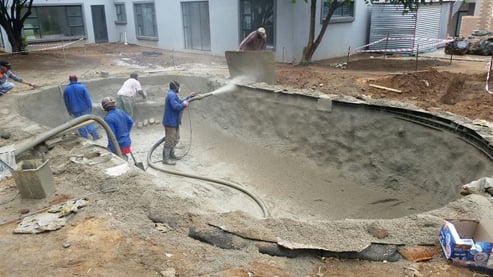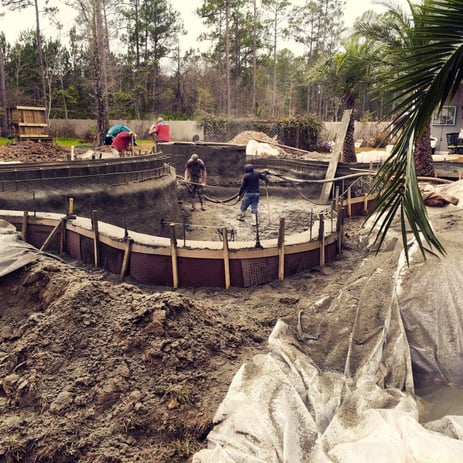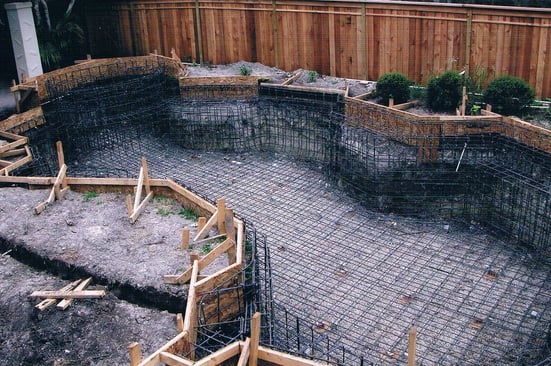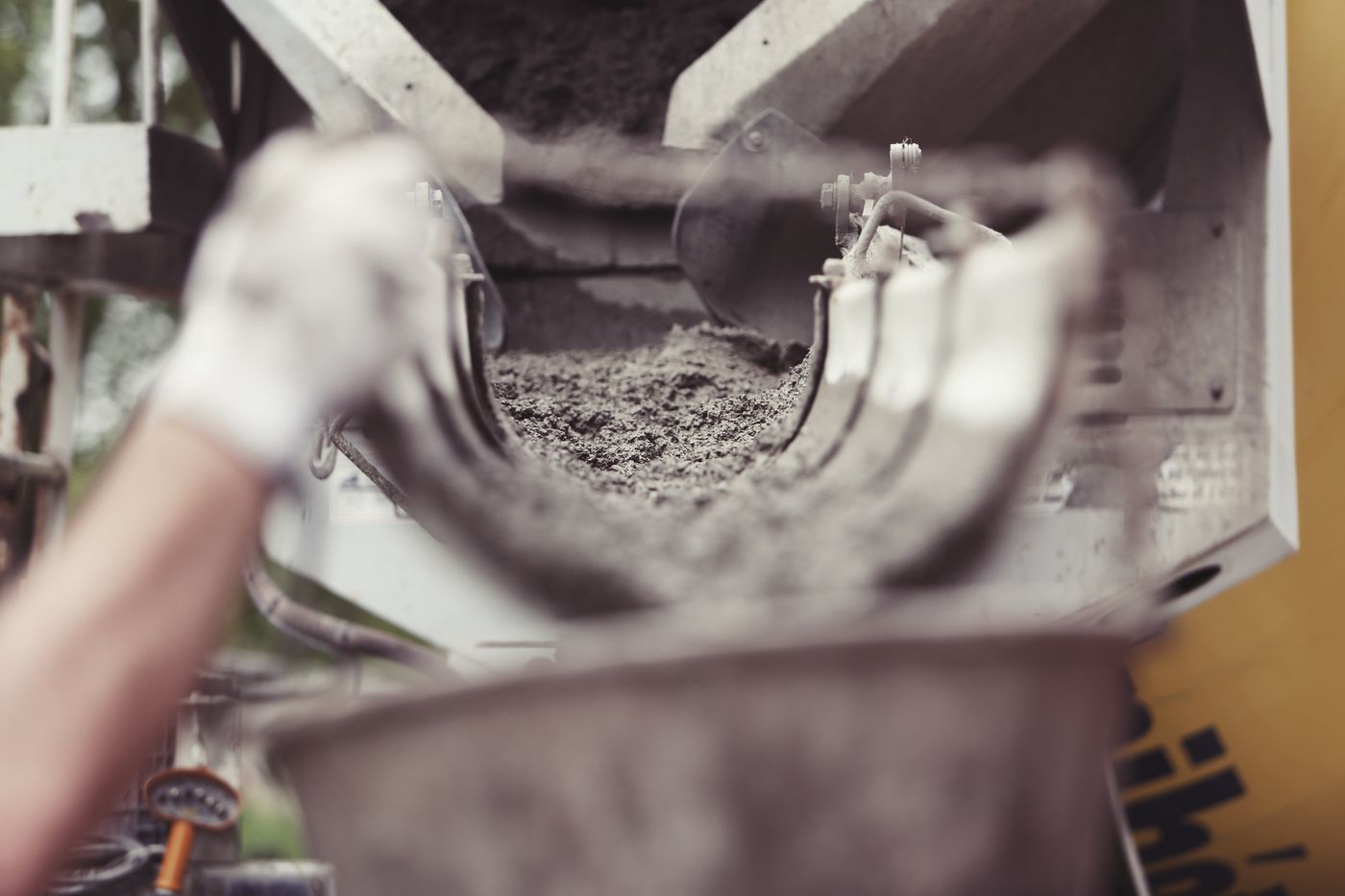If you’re planning to buy a concrete pool, have you ever wished you could time-travel to the future and see what the construction process is like?
Time travel is, of course, the best solution to any question, but in this case we can provide answers without it.
River Pools specializes in fiberglass pools, but we know concrete pools as well. We're here to help you out.
Here in our blog, we provide information on concrete pool design, budgeting, and common maintenance problems so that you can make your big pool decision with all the information.
The process to build your concrete pool is long and complicated, but there’s four key aspects you’ll want to take into account as you decide which direction to go:
- Time
- Mess
- Damage from imbalanced water
- Lots of different work teams
1. Concrete pool construction takes a long time.
The average time frame to build a concrete pool is 3–6 months.
Within that time, the concrete pool shell has to sit empty for 30 days while the concrete cures.

For comparison, a fiberglass pool takes only 3–6 weeks and is full of water by day 2.
Real talk: River Pools has had instances where we begin installing a fiberglass pool and next door a concrete pool is in construction (and has been for a few months already). We’ll finish our project and leave, but that neighbor’s concrete pool is still going on for weeks afterward.
Honestly, I’d feel so smug if I were that customer. “Where’s your new pool, Carol? It’s still not done yet? What a shame. Well, I’m off to take a dip in my new pool.” It’s a whole new level of “keeping up with the Joneses.”
2. Concrete pool construction is messy.
All pool construction is messy, but an in-progress concrete pool is extra bad. The builders are spraying concrete out of a hose (this is typically done using the gunite process) and it gets everywhere. They try to contain the mess, but it’s a lot of dust and a lot of overspraying.
Take that and multiply it by 3–6 months. Talk about a stressful situation. And you thought dishes on the kitchen counter were bad.

3. Imbalanced water could stain or damage the pool surface.
Starting up a concrete pool is really technical and involved.
If you don’t do it right—for example, if the pH or hardness or chlorine is off—you could stain or damage the surface.
.jpg?width=300&height=225&name=pool-stains%20(1).jpg)
4. Multiple phases means multiple teams of workers.
A concrete pool is manufactured and installed all in your backyard.
There are ten phases involved, and each phase requires a different skill set.

Sometimes you’ll have one person who excavates, another person who ties steel, someone else who does plumbing, another person who shoots the pool shell, one company for the tiles, another company for plaster, another for coping and decking…
All those different phases are potentially different people. That’s a lot of people who are coming into your backyard. I’m not saying Stranger Danger, but it can be uncomfortable.
Alternatives to concrete pools
If the idea of concrete pool construction gives you the heebie-jeebies, you may want to compare it to your other options, vinyl liner pools and fiberglass pools.
Vinyl liner pools
Vinyl liner pools only take 4–8 weeks to install, and the initial cost ranges from $20,000–$55,000, which is at least $10,000 less than similar fiberglass or concrete pools. However, you have to replace the liner every 5–9 years, which costs around $4,500 a pop.
They have a smoother surface than a concrete pool but are less durable.
Like concrete pools, you can customize the shape and size of vinyl liner pools to your heart’s content.
Fiberglass pools
Fiberglass pools cost $45,000–$85,000 upfront but have the lowest lifetime maintenance of all three, which saves you money in the long run.
While the shapes and sizes are less customized, most people can find a model that fits their needs.
We build the fiberglass pool shell off-site, and it’s messy for sure! But unlike with concrete or vinyl liner pools, that doesn’t happen in your backyard; it happens here. The pool is cleaned up and looking slick when it gets to your backyard.
Starting up a fiberglass pool correctly is still important, but the pool shell itself is a lot more durable so there’s less chance of stains or damage than there is with a concrete pool.

For a fiberglass pool, we typically have one crew put the pool in, and maybe another crew will do the coping and decking. Our customers like that they work with the same team throughout most of the process.
At River Pools, we manufacture world-class fiberglass swimming pools for installation across North America and have a wide variety of models to choose from. Try our inground pool quote tool today to see how much a fiberglass pool will cost you, or contact us directly for more information.

We look forward to helping you!

Up Next:
What is a Fiberglass Pool Mold?
Editor's note: This blog article was updated on March 15, 2019.
Editor's Note: This article was originally written by Holly Jender on November 2, 2017. Any opinions expressed are those of the author. Any prices referenced were based on information that was readily available at the time.
River Pools is a brand of inground fiberglass pools produced in a manufacturing facility in Fortville, IN. While our expertise is in manufacturing fiberglass pools, we have access to a network of installers with expertise relating to project design, installation, and pool service. We often tap into this knowledge base and share information freely with homeowners, just like you, considering installing a swimming pool in your backyard.





.jpg?width=300&height=225&name=pool-stains%20(1).jpg)



